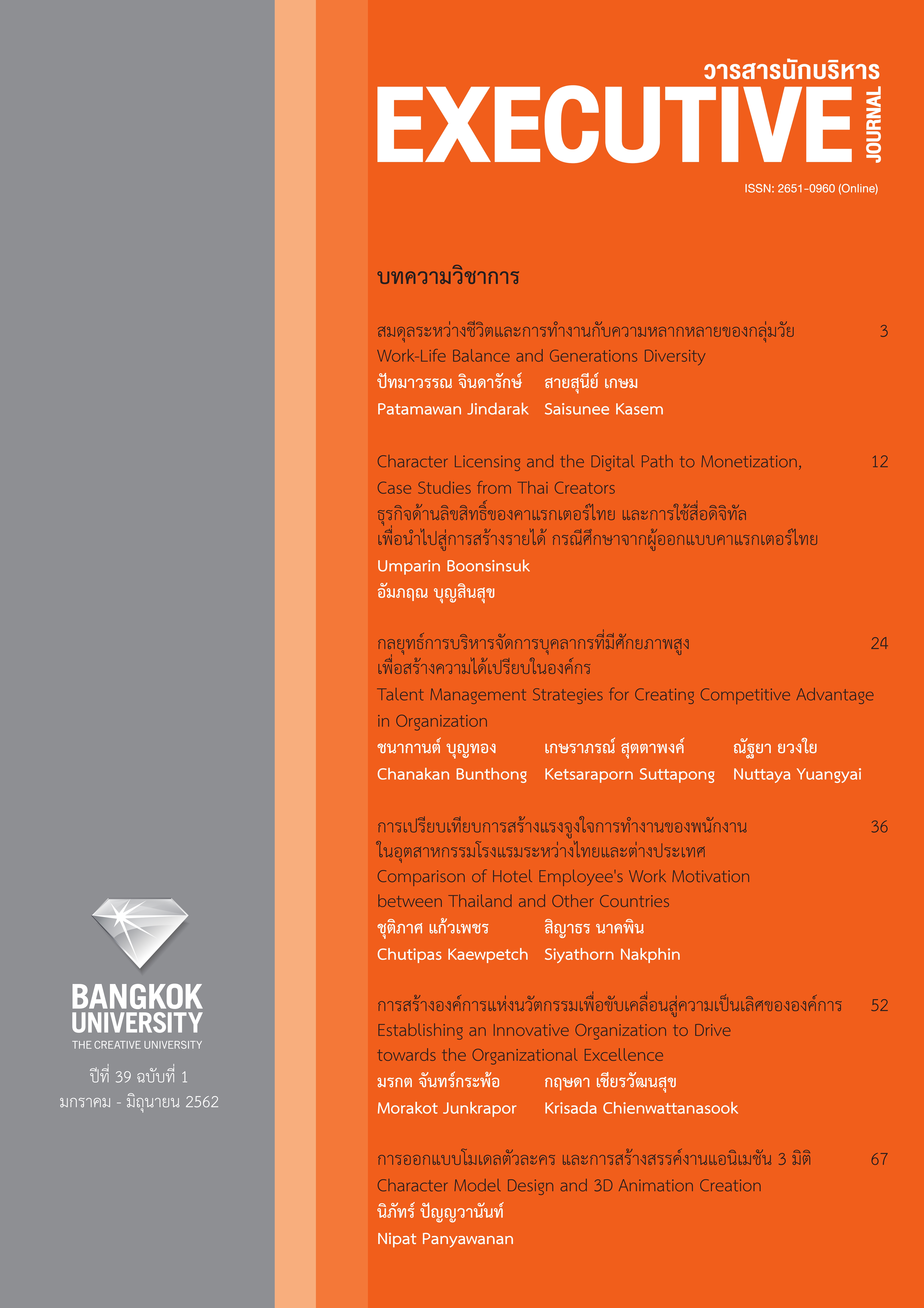Work-Life Balance and Generations Diversity Work-Life Balance and Generations Diversity
Main Article Content
Abstract
Work-life balance (WLB) is an essential factor leading to better quality of life and work efficiency. Presently, there are various forms of work styles that affect WLB, and there are diverse working generations—Baby Boomers, Generation X, Millennial—who need to achieve WLB differently. It has been found that factors affecting WLB include Time Balance, Involvement Balance and Satisfaction Balance. In addition, organizational factors such as supervisor and colleague support as well as individual factors such as family support influence WLB. Consequently, creating an environment conducive to WLB that serves the different expectations of each generation is one of the major functions of Human Resource administrators. This will enhance their employee’s quality of life which will lead to greater work efficiency, and company growth and success.
Article Details
The manuscript submitted for publication must be the original version, submitted only to this particular journal with no prior acceptance for publication elsewhere in other academic journals. The manuscript must also not violate the copyright issue by means of plagiarism.
References
Akakulanan, S. (2011). The causal relationship model of work-life balance affecting the employees’ effective work behavior of the Automotive Part Manufacturers, The Eastern Thailand. Journal of Behavioral Science, 17(2), 85-102.
Cigna. (2018). Khanǣn sukaphāp lǣk hwām pen yū bǣp 360 āongsā khō̜ng signā [The Cigna '360° well-being score]. Retrieved November 2, 2018, from https://www.cigna.co.th/news/360well-being-2018
Delamotte, Y., & Takezawa, S. (1984). Quality of working life in international perspective. Switzerland: International Labor Organization.
Gilbert, J. (2011). The millennials: A new generation of employees, a new set of engagement policies. Ivey Business Journal, 75(5), 26-28.
Greenhaus, J. H., Collins, K. M., & Shaw, J. D. (2003). The relation between work–family balance and quality of life. Journal of Vocational Behavior, 63(3), 510-531.
Haar, J. (2018). Overview of the perpetual guardian 4-day (paid 5) work trial. Retrieved November 12, 2018, form https://news.aut.ac.nz/__data/assets/pdf_file/0019/188002/Final-Perpetual-Guardian-report_Professor-Jarrod-Haar_July-2018.pdf
Hennequin, E. (2007). What “career success” means to blue-collar workers. Career Development International, 12(6), 565-581.
Huse, E. F., & Cummings, T. G. (1985). Organization development and change (3rd ed.). Saint Pual, MN: West Publishing.
Intulak, K., & Oumtanee A. (2014). Building work-life balance of professional nurses in a private hospital. Journal of The Royal Thai Army Nurses, 15(3), 382-389.
Kasem, S. (2016). Khwām sō̜mdun rawāng chiwit kāp kānthamngān khō̜ng buklākō̜n sāiwichākān radāp ūdomsưksā nai chāngwāt chiāngmāi [Work-life balance of the academic staff at higher education in Chiang Mai Province]. Payap University Journal, 26(1), 151-174.
Kohll, A. (2018). The evolving definition of work-life balance. Retrieved November 10, 2018, from https://www.forbes.com/sites/alankohll/2018/03/27/the-evolving-definition-of-work-life-balance/#4f25a4d99ed3
Noor, K. M. (2011). Work-life balance and intention to leave among academics in Malaysian public higher education institutions. International Journal of Business and Social Science, 2(11), 240-248.
Ratanachina, J., Rattananupong, T., & Sithisarankul, P. (2016). Sō̜mdun ngān lǣ chiwit khō̜ng phanakngān klumwāi minlenniān lǣ phāitai thi kiāokhō̜ng [Work-life balance and associated factors]. Chula Med Journal, 60(5), 509-521.
Sirichotiratana, N. (2017). Lakkān bō̜rihān sapphayākō̜n manut nai satawat 21 (Phim khrang thī sām) [The principle of human resource management in 21st century (3rd ed.)]. Bangkok: Chulalongkorn University Press.
SME Thailand. (2018). Bō̜rihān kō̜n yuk disrupted economy [Human resource management in disruptive era]. Retrieved October 5, 2018, from https://www.smethailandclub.com/human-3106-id.html
Somsert, S. ( 2018). The way to happiness at work. Executive Journal, 38(1), 3-10.
Thongkamkaew, W. (2012). Sō̜mdun Chiwit kānthamngān phāitai nǣokhit kānčhatkān khwāmrū [Work life balance: Work life balance bese on knowledge management concept: Work life balance]. Retrieved November 2, 2018, form https://human.skru.ac.th/images/article/t11-55.pdf
Winroth, C. (2017). 6-Hour working day: The Swedish story or whatever happened to the 6-hour Day?. Retrieved November 2, 2018, form https://eurocite.eu/wp-content/uploads/2017/04/ Winroth-6-hour-working-day-Sweden.pdf


